What Cow Breeds Have the Fluffiest Coats?
What do you picture when you think of “cute livestock”? If your brain does not automatically pull up an image of a cow, then you haven’t seen the fluffy ones! There are several breeds of cow that are fluffier, furrier, and/or hairier than the typical Black Angus.
What are the top ten fluffiest cow breeds? The breed with the longest coat is the Highland, but there are several other breeds that have a coat ranging from long, to fluffy, to seasonally dense and thick. Here is a list of the top ten fluffiest cows, ranging from full Winter coats at the top, to long and luxurious coats at the bottom:
- Hereford
- Welsh Black
- Whitebred Shorthorn
- Shetland
- Luing
- South Devon
- Chillingham
- Belted Galloway
- Galloway
- Highland
More and more people are starting to own cows as pets and companions rather than just for farming. If you’re interested in adding a cute cow to your homestead, read on to learn about each of the breeds mentioned above!
Fluffy Cow #1: Hereford
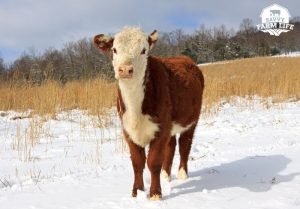
Because thicker, longer coats are often the result of breeding for hardiness, most of the breeds in this list will have originated from European countries, with colder Northern climates. The Hereford is no exception, and is notably the first recognized English cattle breed.
Because they “fluff out” exceptionally well in the Winter, they are hardy in the coldest of regions, and are known for their vigor, longevity, and the ability to produce calves well into their later years. Herefords have a red and white coat, which is short and manageable in the Summer, and fluffy and warm in the Winter.
Fluffy Cow #2: Welsh Black
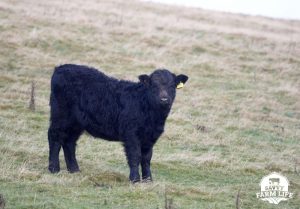
Like the Hereford, the Welsh Black is known for its hardiness in cold climates and will grow a thick, fluffy Winter coat each year that is sheds in the Spring. As its name implies, the Welsh Black is typically solid black in color, while the red recessive gene will produce solid red calves.
The Welsh Black has British origins, and is usually unphased by the harsh rain and snow. In fact, farmers with mixed herds will often see their Welsh Blacks out grazing in the brutal weather while the other breeds gather under a shelter. Welsh Blacks are notorious for their adaptability and tolerance to extreme weather.
Fluffy Cow #3: Whitebred Shorthorn
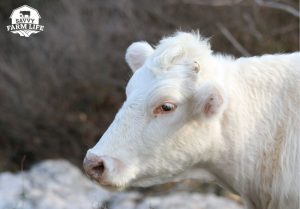
The Whitebred Shorthorn is another English breed, and is white in color with a soft overcoat and a thick, fluffy undercoat. The Whitebred Shorthorn is a different breed than the Beef and Dairy Shorthorn, and is considered a rare breed.
The Whitebred Shorthorn is primarily bred to be used in cross-breeding, with the bulls more commonly cross-breeding with cows (females) of other breeds. The goal of this cross-breeding is to take advantage of the cold-hardiness and the ability to thrive on less-than-ideal pasture, creating a lower-maintenance breed that also produces quality meat.
Fluffy Cow #4: Shetland
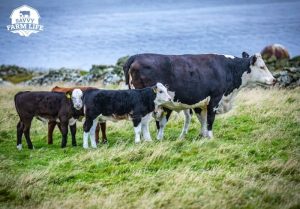
The Shetland is an ancient breed of Viking heritage. Shetlands are considered a vulnerable breed today, and are not as common as the other breeds on this list. Shetlands are most commonly black and white, but also come in red-and-white and solid color varieties.
Like the previous three breeds in this list, Shetlands will have a short, sleek coat in the Summer. Around August, however, they begin to accumulate their Winter coats – a coat of longer, denser hair that helps insulate them from the cold, harsh Winters to which they are accustomed.
Fluffy Cow #5: Luing
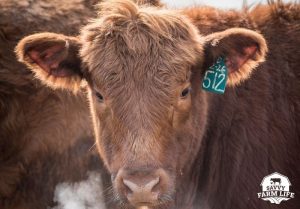
The Luing is a Scottish breed developed in the 1950’s by crossing the Highlander (for its hardiness) and Beef Shorthorn (for its quality of beef). The result was a quality-producing breed that thrives in Northern climates and on poor quality pasture. Luings (pronounced “lings”) have a thick coat of red, golden, or white hair that develops into a heavy, fluffy coat in the Winter.
Luings are known for their exceptional feed efficiency compared to other cattle, requiring less feed energy in the Winter conditions – this is due to their especially thick and insulated coat that keeps them warm. Luings also have what is called “weather instinct” – they instinctively seek out shelter when they require it, unlike some other breeds.
Fluffy Cow #6: South Devon
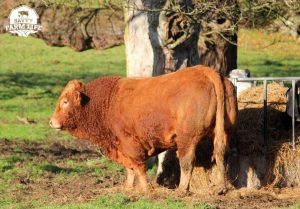
The South Devon is another English breed, and one that first came to North America on the Mayflower in the 1600’s. South Devons are generally red in color, though some may carry a mottled appearance. Their coat is naturally dense and curly, giving them a year-round fluffy appearance. South Devons are one of the largest English breeds of cattle, and produce a superior quality of beef.
Fluffy Cow #7: Chillingham
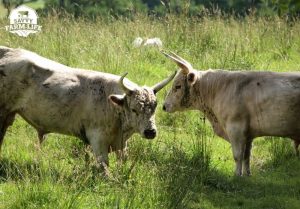
The Chillingham is unique within our list because it is the only breed that is entirely wild. You cannot bring a Chillingham to your homestead.
The Chillingham cattle live in an isolated, protected herd in England. They are white in color and have fluffy, long white coats. Following a drastic reduction in numbers in the harsh Winter of 1947, there is another “secret” herd of Chillingham that is maintained in an undisclosed location in Scotland in case the English herd suffers unanticipated losses. While you cannot purchase a Chillingham calf for your own farm, I added it to this list because of its unique, luxurious coat.
Fluffy Cow #8: Galloway
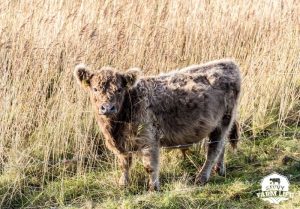
And here is where we get into the really fluffy cows. The Galloway is a Scottish breed and is known for its wavy coat – a coat consisting of a longer, coarser overcoat and a softer, denser undercoat. This coat protects the Galloway from harsh Winter climates, and is essentially waterproof – making it an excellent choice of breed for cold, wet regions.
Galloways have the densest coat of any breed of cow. In fact, only the Buffalo has a denser coat. Because of this insulation, Galloways do not have the extra outer layer of fat that most other breeds have, because it is not needed for temperature control.
Fluffy Cow #9: Belted Galloway
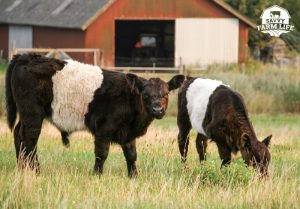
The Belted Galloway is bred from the traditional Galloway, and is black in color with a thick, distinct white “belt” around its middle. Belted Galloways are also called “belties” and “oreos”, due to their white belt sandwiched between their two black halves.
Belted Galloways, like their parent breed, have a double coat of long hair and a soft undercoat. This coat protects them from the penetrating rain and cold and almost eliminates the need for erecting a shelter in most locations.
If you think these fluffy oreos are cute, wait until you see their miniature version. Belted Galloways come in a mini variety, and top out at 48” or smaller (or about waist-high to an adult human). The demand for miniature cattle is growing as smaller homesteaders look for an alternative to the typical 1,500-pound cow, and the Belted Galloway does not disappoint in either size or cuteness.
Fluffy Cow #10: Highland
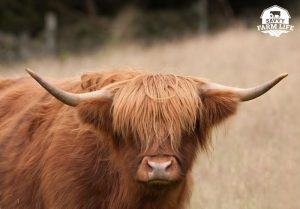
The Highland is arguably the breed best-suited for the harshest, Northernmost climates. Highland cattle originated from Scotland and are known for their downy undercoat, long overcoat, and bang-like fringe that appears to cover the eyes (but actually plays an important role in protecting the eyes). Their long overcoat can reach up to 14 inches in length. Highlands are a beautiful breed and are the quintessential “fluffy cow” – this is the breed that you see depicted in paintings and home decor that have been so popular in recent years.
With cold, harsh weather often comes harsh terrain and low-quality forage. Many of the breeds that are bred for harsh climates are also naturally good foragers and able to thrive on pasture that is not ideal. The Highland is no exception, and especially efficient at converting poor quality forage to energy. Though the luxurious coat may give the Highland a pampered appearance, this breed is hardy, strong, low-maintenance, and far from delicate
Can Any Cow Be A Fluffy Cow?
If you have ever heard of “Iowa’s Fluffy Cows” or Lautner Farms, you may have seen pictures of their teddy bear-soft fluffy coats. These cows, while beautifully unique in appearance, are not bred for their coats. These are show steers who are groomed and primped for hours to obtain this soft, furry look.
These show steers undergo months of daily (or sometimes twice daily) grooming to achieve these fluffy coats. They are popular as FFA and 4H projects, and have gained notoriety around the nation. To achieve this beautiful coat, these steers are washed, clipped, and blow-dried. Their coat is massaged with specialty oils and covered in “cow hairspray” after the grooming. So in theory, yes, you can give your short-haired cow a fluffy makeover, but it will take a significant time commitment!
Though the fluffy cow that most of us are familiar with is the Highland, there are a handful of other breeds that also come with a soft, fluffy coat. And some of them even come in a miniature version! If you are looking for a hardy breed with a luxurious coat, take a look at some of the breeds mentioned in this article to see if any of them would be a good fit for your homestead.
Can the cows on this list be used for milk? Any cow can produce milk, although certain breeds have been especially bred for their high milk production. To learn about how often cows produce milk, visit my article How Often Do Cows Produce Milk?
